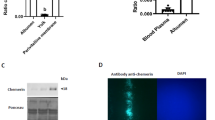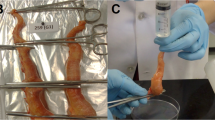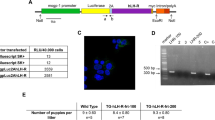Abstract
ETHIONINE is a potent carcinogen, but little is known about its mode of action. It is known that it does not react extensively with DNA1. It may be an ubiquitous carcinogen, as it is synthesised by Escherichia coli2 and several other microorganisms, so studies of its mode of action are important. We reported recently a novel effect of ethionine in the immature chick3. The oviducts of chicks previously stimulated with oestrogen behaved after the administration of ethionine as if they had received a second stimulation with oestrogen or progestin4–6. The egg white proteins, ovalbumin and conalbumin were synthesised and distinct morphological changes, characteristic of stimulation by oestrogen or progestin appeared. It was thus not clear whether ethionine (or its metabolic product) was affecting steroid hormone receptors7 directly, or interferring in some way with steroid hormone metabolism to produce elevated levels of endogenous oestrogen or progestin. We report here that ethionine or its sulphoxide are unique in inducing in the chick oviduct the effects cited above; analogues were inactive. We also report that the administration of ethionine elevates serum progesterone levels over 10-fold, to a concentration which may be sufficient to account for the profound changes in the immature oviduct.
This is a preview of subscription content, access via your institution
Access options
Subscribe to this journal
Receive 51 print issues and online access
$199.00 per year
only $3.90 per issue
Buy this article
- Purchase on Springer Link
- Instant access to full article PDF
Prices may be subject to local taxes which are calculated during checkout
Similar content being viewed by others
References
Farber, E. Cancer Res. 33, 2537–2550 (1973).
Fisher, J. F. & Mallette, M. F. J. gen. Physiol. 45, 1–13 (1961).
Sharma, O. K., Borek, E. & Martinez-Hernandez, A. Nature 259, 588–591 (1976).
Oka, T. & Schimke, T. R. J. Cell Biol. 43, 123–137 (1969).
Palmiter, R. D., Christensen, A. K. & Schimke, R. T. J. biol. Chem. 245, 833–845 (1970).
Palmiter, R. D. & Wrenn, J. J. Cell Biol. 50 598–615 (1971).
O'Malley, B. W. & Means, A. R. Science 183, 610–620 (1974).
O'Malley, B. W., McGuire, W. L., Kohler, P. O. & Korenman, S. G. Rec. Prog. Hormone Res. 25, 105–160 (1969).
Kohler, P. O., Grimley, P. M. & O'Malley, B. W. J. Cell Biol. 40, 8–26 (1969).
Oka, T. & Schimke, R. T. J. Cell Biol. 41, 816–823 (1969).
Palmiter, R. D. Cell 4, 189–197 (1975).
Brada, A., Bulba, S. & Cohen, J. Cancer Res. 35, 2674–2683 (1975).
Palmiter, R. D., Oka, T. & Schimke, R. T. J. biol. Chem. 246, 724–737 (1971).
Sharma, O. K., Mays, L. L. & Borek, E. J. biol. Chem. 248, 7622–7624 (1973).
Sharma, O. K., Mays, L. L. & Borek, E. Biochemistry 14, 509–514 (1975).
Sharma, O. K., Beezley, D. N. & Borek, E. Nature 262, 62–63 (1976).
Borek, E. & Waelsch, H. J. biol. Chem. 177, 135–141 (1949).
DeVilla, G. O., Roberts, K., Wiest, W. G., Mikhail, G. & Flickinger, G. J. clin. endocrinol. Metab. 35, 458–460 (1972).
Wu, C. & Lundy, L. E. Steroids 18, 91–111 (1971).
Chiamori, N. & Henri, R. D. Am. J. Pathol. 31, 305–309 (1959).
Sabine, J. R. Prog. Biochem. Pharmacol. 10, 269–307 (1975).
Chen, H. W., Kandutsh, A. A., Heiniger, H. & Meier, H. Cancer Res. 33, 2774–2778 (1973).
Furth, J. Cancer 1, 75–120 (1975).
Author information
Authors and Affiliations
Rights and permissions
About this article
Cite this article
SHARMA, O., BOREK, E. The carcinogen ethionine elevates progesterone levels. Nature 265, 748–749 (1977). https://doi.org/10.1038/265748a0
Received:
Accepted:
Issue Date:
DOI: https://doi.org/10.1038/265748a0
This article is cited by
Comments
By submitting a comment you agree to abide by our Terms and Community Guidelines. If you find something abusive or that does not comply with our terms or guidelines please flag it as inappropriate.



